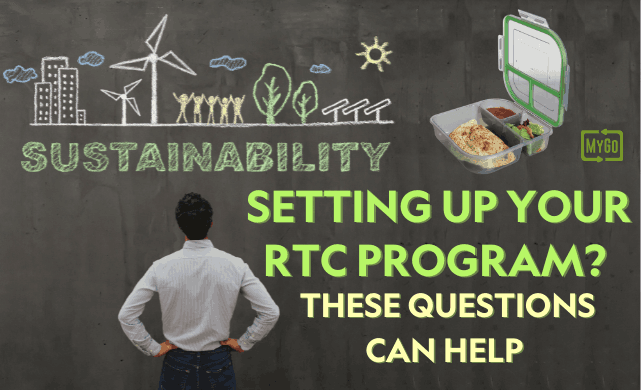Reusable To-Go Containers (RTC) have been around in colleges and universities for more than a decade now. Some of the top manufacturers are quite well-known and easily accessible, with MyGo Containers™ being a fairly recent addition to the market. Even though institutions of higher learning have been implementing RTC systems in their dining halls for over ten years, the pandemic has significantly boosted interest in this sustainable solution. The shift to takeout during the pandemic highlighted the environmental impact of single-use packaging and underscored the importance of reducing waste in campus dining operations. As many colleges and universities explore launching or expanding their RTC programs, one of the most frequent discussions at regional NACUFS conferences has been about setting up an effective RTC program. It’s a great question indeed! Designing an RTC program tailored to a specific campus involves numerous considerations. Initially, we thought our main task would be guiding schools in choosing between larger three-compartment MyGo Containers or their smaller counterparts. However, that turned out to be one of the simpler decisions. Each campus is unique in terms of food service operations, layout, meal plans, student demographics, and priorities. Therefore, we believe a one-size-fits-all approach isn’t suitable. Nevertheless, we’re equipped to assist in developing an RTC program that aligns with your students’ preferences and supports your organization’s goals. To kickstart creating the perfect RTC program for your campus, here’s a list of questions to guide you toward establishing a robust, sustainable initiative: - What types of reusable to-go containers should you offer in your dining halls or food service outlets? - How many containers will be needed daily to meet demand? Where will these containers be stored? - Where should the return collection bins be placed to ensure ease of access for participants? - Who will be responsible for collecting used containers from these bins? - Who will clean the containers, where will the clean ones be stored, and who will ensure proper storage? - What kind of training is necessary for the RTC program, how will it be delivered, and who will oversee it? - When will containers be made available to students? - What accountability system will be implemented? If a deposit is collected from students, how much will it be, and what will they receive in return? - Who will manage and monitor the accountability system? - How will staff be held accountable for thoroughly cleaning and sanitizing the containers? - Where might theft occur, and what preventive measures can be taken? - How will you educate your student body and other customers about the benefits of the new RTC program? - Who will handle marketing and education regarding the program? Is there a budget for supporting it? - What does success look like for all stakeholders? While answering these questions won’t provide a complete RTC program, they’ll help you build a framework that can be fleshed out with details as you address each one. For additional guidance in launching an RTC program at your institution, Cook’s is here with MyGo Containers™ and extensive experience helping other colleges, universities, and schools implement successful RTC programs that are both financially viable and environmentally conscious.

Keywords: RTC PROGRAM
Custom Greeting Cards,Custom Cards Printing,Custom Greeting Card Printing,Personalized Greeting Cards
Guangzhou Xinqicai Printing Co., Ltd. , https://www.cnxqcprinting.com




